Creating a Heart-Safe School for Your Child
- Sep 24, 2018

There is much work to be done to ensure that our children are not only receiving a good education but are protected and can survive should a sudden cardiac arrest medical crisis occur.
Picture a typical High School teeming with students and staff moving through the various buildings, classrooms, gymnasiums, tracks and playing fields. These settings are designed to nurture and educate our children and it is where they along with parents, grandparents, staff, other school sports teams, etc. spend the large majority of their day. Within this framework more than 7,000 people under the age of 18 die from Sudden Cardiac Arrest (SCA) annually. That number translates to almost 20 children per day. SCA is the leading cause of death in young athletes and the leading overall cause of death in the United States (250,000 lives lost annually). Just 1 in 10 US student athletes who suffer SCA survive. How can we help lower these numbers and create heart-safe schools?
Currently, the following state laws are in effect (courtesy of The National Conference of State Legislators website www.ncsl.org)
California “urges” K-12 schools to implement AED programs (2005), Colorado (donations), Florida, Georgia (2008), Illinois, Iowa (2010), Maryland, Michigan, Nevada, New York, Ohio, Pennsylvania, South Carolina (2008), Virginia and Wisconsin (2010) require some schools to have portable defibrillators; actual extent varies. Tennessee“encourages” placement in schools (2008.)
Based on these glaring facts and the largely unmandated circumstances state to state, there is much work to be done to ensure that our children are not only receiving a good education but are protected and can survive should a sudden cardiac arrest medical crisis occur. This work is being furthered passionately and sadly by family members that have lost a child to SCA who may have been saved if an AED were used in time for their child.
Student athletes are at the highest risk of sudden cardiac arrest, which occurs without warning when the heart’s electrical system stops working. Access to an AED within 3-5 minutes is the difference between life and death.
What can we do to provide a heart-safe school for our children? We require them to wear helmets and pads when riding bicycles, they must wear seat belts when riding in a car, fire safety is practiced, with fire inspections occurring regularly. But, how do we identify potential hidden medical issues, and ensure that something as critical as having access to an AED during their school day is provided?
If you have a student athlete, you are familiar with taking your child to your physician for a basic check-up. This is typically the only “pre-screening” that your child will undergo prior to playing a school related sport. The first potential problem is that there is not a standardized and universal form that ensures that certain critical information is covered. A physical can be as basic as a short meeting with a medical professional without answering critical questions that might identify a risk, but will deliver a signed form to the school system. Some schools systems have created more in-depth forms that require more detailed medical history and address questions about family health history as well as heart specific questions about chest pain, irregular heartbeats, fainting, and high cholesterol. So, the first step into a child’s participation in school sports may or may not provide necessary and critical information that could be gleaned at this juncture.
The next question parents must ask is whether or not the school has an AED on the premises. Is there an AED? Where is the AED located? Is it accessible at all times? Does the school have a portable AED at outdoor events and on the athletic fields? Are the coaches required to be CPR-certified? Is there an emergency action plan in place? There are heartbreaking stories about an AED being on site, but locked up in a nurse’s office and unavailable during a sport event, for example. Tennessee law says that the first AED a school has must be located outside of the gymnasium. During a sporting event, whether it is in the gymnasium, or on the outside fields, is an AED accessible at all times in the event someone collapses due to sudden cardiac arrest? The AED must be at the victim’s side and ready to deliver the life saving shock within 4-6 minutes.
The American Heart Association refers to the “Chain of Survival” that must be in place to save the life of a sudden cardiac arrest victim. The chart below speaks for itself. When someone collapses due to a sudden cardiac arrest, the clock begins ticking and it is a race against the clock. The stark fact is that if an AED is not at the victim’s side within 6 minutes, the victim will not survive. The general rule of thumb is that the AED must be within a 60-90 second access time. This requires that there is an emergency plan that is understood by staff, and will ensure that the “Chain of Survival” is successful in saving a life.
In 1990, the American Heart Association developed the Chain of Survival. This protocol addresses the fact that most SCA episodes occur outside of a hospital, with death occurring within minutes of onset. For the Chain to be effective, quick execution of each and every link is critical. With each minute that passes, the likelihood of survival decreases 7-10%.
To provide the best opportunity for survival, each of these four links must be put into motion within the first few minutes of SCA onset:
- Early Access to Emergency Care must be provided by calling 911.
- Early CPR should be started and maintained until emergency medical services (EMS) arrive.
- Early Defibrillation is the only one that can re-start the heart function of a person with ventricular fibrillation (VF). If an automated external defibrillator (AED) is available, a trained operator should administer defibrillation as quickly as possible until EMS personnel arrive.
- Early Advanced Care, the final link, can then be administered as needed by EMS personnel.
- The cost of an AED is between $1,000 and $2,000. Think about this fact for a moment with regard to sudden cardiac arrest and a child… The difference between life and death costing no more than $2,000. If your child’s school does not have an AED or an AED Program, be the voice of reason in changing this one fact. Cost should not be a stumbling block. Convincing a school board of the need for an SCA program should not be difficult, but it may take preparation. Being armed with your state’s Good Samaritan Law will go a long way in diffusing fear of liability. Schools are protected not only by state laws, but also by the federal Cardiac Arrest Survival Act which pre-empts state laws, providing additional protection for users and acquires of AEDs. There are a wide variety of resources available to draw upon in getting your schools program in place quickly. You can contact http://www.sca-aware.org/sca-resources/aed-laws for more information on resources.
- Two common recommendations for AEDs in school settings are:Zoll AED Plus & Cardiac Science PowerHeart G3An emergency plan must incorporate the management and maintenance of the AED(s), by ensuring that pads and batteries are within expiration dates.The next step in the “Chain of Survival” is to create a new generation of trained rescuers to the population. There are many state and school system programs that are incorporating CPR and AED training into the school curriculum. We can add a million trained rescuers to the population every few years. There will be a time, hopefully in the not too distant future, where sudden cardiac arrest will not take the lives of so many of our loved ones.There are many cautionary tales that we all hear and see through the media. AED’s save lives, and the lack of an AED within a limited amount of time will mean death to someone’s loved one. It is too important not to be educated about these facts, especially when an AED could mean the difference between life and death for a young person with their future in front of them.





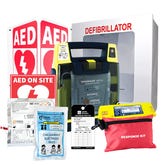
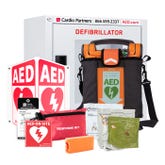
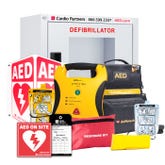
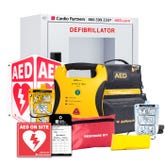
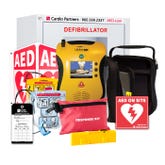
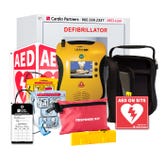
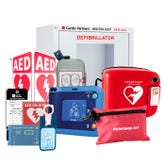
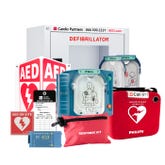
 CALL US:
CALL US: